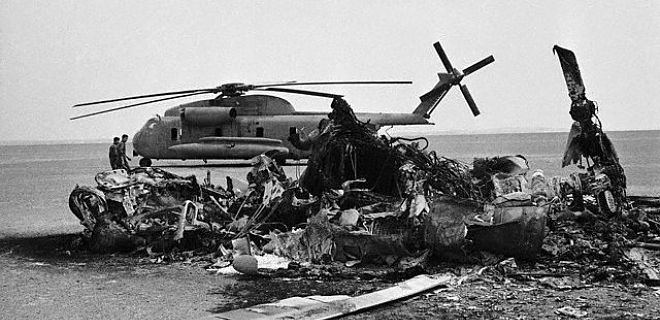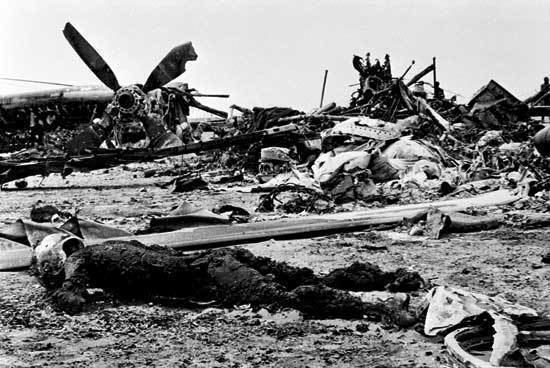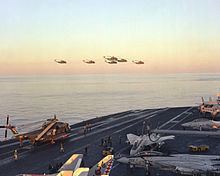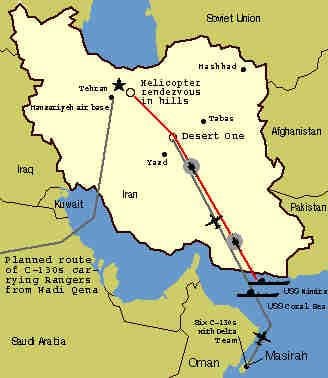Dates 24 Apr 1980 – 25 Apr 1980 | ||
 | ||
Commanded by United States President Jimmy Carter Maj. Gen. James B. Vaught Col. James H. Kyle Lt. Col. Edward R. Seiffert Col. Charles A. Beckwith Executed by United States ArmyDelta ForceU.S. Army Rangers Central Intelligence AgencySpecial Activities DivisionLogistical support: United States Air Force U.S. Marine Corps U.S. Navy Outcome Mission failed1 helicopter and 1 transport aircraft destroyed5 helicopters abandoned/captured Casualties 8 U.S. servicemen killed & 4 injured1 Iranian civilian killed Results Mission failed, 1 helicopter and 1 transport aircraft destroyed, 5 helicopters abandoned/captured Similar Iran Hostage Crisis, Invasion of Grenada, United States invasion, operation Gothic Serpent, Operation Acid Gambit | ||
Operation eagle claw
Operation Eagle Claw (Persian: عملیات طبس) (or Operation Evening Light or Operation Rice Bowl) was a United States Armed Forces operation ordered by US President Jimmy Carter to attempt to end the Iran hostage crisis by rescuing 52 embassy staff held captive at the Embassy of the United States, Tehran on 24 April 1980. Its failure, and the humiliating public debacle that ensued, damaged US prestige worldwide. Carter himself blamed his loss in the 1980 US presidential election mainly on his failure to win the release of U.S. hostages held captive in Iran.
Contents
- Operation eagle claw
- Preparing for the operation
- Finalized plan
- Commencement of the mission
- Debacle
- Aftermath
- Analysis
- US Air Force
- US Army
- US Navy and Marine Corps
- Aircraft on Display
- Irans damage claim
- References

The operation encountered many obstacles and was eventually aborted. Eight helicopters were sent to the first staging area, Desert One, but only five arrived in operational condition. One encountered hydraulic problems, another got caught in a cloud of very fine sand, and the last one showed signs of a cracked rotor blade. During planning it was decided that the mission would be aborted if fewer than six helicopters remained, despite only four being absolutely necessary. In a move that is still discussed in military circles, the field commanders advised mission abort, which President Carter accepted and confirmed.

As the U.S. force prepared to leave, one of the helicopters crashed into a transport aircraft which contained both servicemen and jet fuel. The resulting fire destroyed both aircraft and killed eight servicemen. Operation Eagle Claw was one of Delta Force's first missions.

Operation eagle claw
Preparing for the operation

The Joint Task Force commander was Army Major General James B. Vaught, to be forward based at Wadi Kena, Egypt, and reporting directly to the President. Reporting to General Vaught were field commanders USAF Colonel James H. Kyle for aviation, and US Army Delta Force Colonel Charlie Beckwith for ground forces.

The Tehran CIA Special Activities Division paramilitary team, led by retired U.S. Army Special Forces officer Richard J. Meadows, had two assignments: to obtain information about the hostages and the embassy grounds, and to transport the rescuers from Desert Two, a site just outside Tehran, to the embassy grounds in pre-staged vehicles. In reality, the most important information came from an embassy cook released by the Iranians. He was discovered on a flight from Tehran at the last minute by another CIA officer, and confirmed that the hostages were centrally located in the embassy compound – this was a key piece of information long sought by the planners.

On 1 April, three weeks before the operation, a U.S. Air Force Combat Controller, Major John T. Carney Jr., was flown in a Twin Otter to Desert One, a staging area in the Khorasan Province of Iran, near Tabas (Now South Khorasan Province) by two CIA officers for a clandestine survey of an airstrip. Despite their casual approach to the mission, Carney successfully surveyed the airstrip, installed remotely operated infrared lights and a strobe to outline a landing pattern for pilots, and took soil samples to determine the load-bearing properties of the desert surface. At that time, the floor was hard-packed sand, but in the ensuing three weeks, an ankle-deep layer of powdery sand was deposited by sandstorms. The "box four and one" pattern acted like a gun sight, with the distant fifth light at the end of the runway lined up in the center of the near four lights positioned at the approach end. The box provided a touchdown area and the far light marked the end of the rollout area.
Finalized plan
The operation was designed as a complex two-night mission. On the first night, the aircraft would enter Iran in a remote coastal area 60 miles west of Chabahar, and fly to Desert One (33°04′23″N 55°53′33″E) via the Dasht-e Lut desert. Desert One would be secured and established with a protection force and approximately 6,000 gallons of jet fuel would be brought to the area in collapsible fuel bladders carried by United States Air Force (USAF) C-130 aircraft. Three EC-130Es (Call signs: Republic 4 to 6) would carry The Delta Force and other protection elements and three MC-130E Combat Talons (Call signs: Dragon 1 to 3) would carry the logistical supplies. Next, eight United States Navy (USN) RH-53D Sea Stallion helicopters from HELMINERON 16 (Call signs: Bluebeard 1 to 8) would arrive from the USS Nimitz. The helicopters would refuel and fly the Delta Force soldiers 260 miles further to Desert Two (35°14′00″N 52°09′00″E), located 52 miles short of Tehran. Because it would be close to morning, the helicopters and ground forces would hide during the day at Desert Two. The second night would involve the rescue operation. First, CIA agents who were already inside Iran would bring trucks to Desert Two. Together, the CIA agents and ground forces would then drive from Desert Two into Tehran. While the main assault force was moving to Tehran, other US troops would disable electrical power to the area, in an effort to slow any response from the Iranian military. In addition, AC-130 gunships would be deployed over Tehran to provide any necessary supporting fire. Lastly, Army Rangers would capture the nearby Manzariyeh Air Base (34°58′58″N 50°48′20″E) so that several C-141 Starlifters could arrive. The ground troops would then assault the embassy and eliminate the guards. Afterwards the hostages and troops would rendezvous with the helicopters across the street at the Amjadieh Stadium. Finally, the helicopters would bring everyone to the Manzariyeh Air Base, where the C-141s could fly everyone back to friendly territory. Protection for the operation was to be provided by Carrier Air Wing 8 (CVW-8) operating from the USS Nimitz and CVW-14 operating from the USS Coral Sea. For this operation, the aircraft bore special invasion stripes identification on their right wings. CVW-14 Marine F-4Ns had a red (VMFA-323) or yellow (VMFA-531) stripe enclosed by two black stripes. CVW-14 attack aircraft (A-7s and A-6s) had an orange stripe enclosed by two black stripes. Nimitz aircraft were marked in a similar fashion to help differentiate US aircraft from Iranian aircraft purchased from the US (F-14 Tomcats and F-4 Phantoms).
Commencement of the mission
Only the delivery of the protection element / rescue team, equipment and fuel by the C-130 aircraft went according to plan. The special operations transports took off from their staging base at Masirah Island near Oman and flew to Desert One. Dragon 1 landed at 22:45 local time after the hidden lights were activated. The landing was made under blacked-out conditions using the improvised infrared landing light system installed by Carney on the airstrip, visible only through night vision goggles. The heavily loaded Dragon 1 required four passes to determine that there were no obstructions on the airstrip and to align with the runway. The landing resulted in substantial wing damage to the aircraft that later required it be rebuilt "from the ground up", but no one was hurt and it remained flyable. Dragon 1 off-loaded Kyle, a USAF Combat Control Team (CCT) commanded by Carney and Beckwith.
The assault team consisted of 120 Delta soldiers, 12 Rangers forming the roadblock team, and 15 Iranian and American Persian-speakers, most of whom would act as truck drivers. The CCT established a parallel landing zone north of the dirt road and set out TACAN beacons to guide in the helicopters. The second and third MC-130s landed using both runways and discharged the remainder of the Delta soldiers, after which Dragon 1 and 2 took off at 23:15 to make room for the EC-130s and the eight RH-53Ds and to return to base to allow the crews to prepare for the second night operations.
Soon after the first crews landed and began securing Desert One, a tanker truck, apparently smuggling fuel, was blown up nearby by the Army Ranger roadblock team using a shoulder-fired rocket as it tried to escape the site. The truck's passenger was killed, but the driver managed to escape in an accompanying pickup truck. As the tanker truck was evaluated to be engaged in clandestine smuggling, the driver was not considered to pose a security threat to the mission. The resulting fire illuminated the nighttime landscape for many miles around, and actually provided a visual guide to Desert One for the disoriented incoming helicopters. A civilian Iranian bus with a driver and 43 passengers traveling on the same road, which now served as the runway for the aircraft, was forced to halt at approximately the same time and the passengers were detained aboard Republic 3.
While en route, Bluebeard 6 was grounded and abandoned in the desert when its pilots interpreted a sensor indication as a cracked rotor blade. Its crew was picked up by Bluebeard 8. The remaining helicopters ran into an unexpected weather phenomenon known as a haboob (an enormous, nearly opaque cloud of fine dust particles that can follow a thunderstorm). Bluebeard 5 flew into the haboob, but abandoned the mission and returned to the Nimitz when erratic flight instrumentation (altitude indicator) made flying without visual reference points impossible. The scattered formation reached Desert One, 50 to 90 minutes behind schedule. Bluebeard 2 arrived last at Desert One at 01:00 with a malfunctioning second-stage hydraulic system, leaving one hydraulic system to control the aircraft.
With only five helicopters remaining to transport the men and equipment to Desert Two, which Beckwith considered was the mission's abort threshold, the various commanders reached a stalemate. Helicopter commander Seiffert refused to use Bluebeard 2 on the mission, while Beckwith refused to reduce his rescue team's size. Beckwith failed to incorporate intelligence from a Canadian diplomatic source into an alternative plan in case of aircraft failure–additionally, he anticipated losing additional helicopters at later stages, especially as they were notorious for failing on cold starts and they were to be shut down for almost 24 hours at Desert Two. Kyle recommended to Vaught that the mission be aborted. The recommendation was passed on by satellite radio up to the President. After two and a half hours on the ground, the abort order was received.
Debacle
Fuel consumption calculations showed that the extra 90 minutes idling on the ground had made fuel critical for one of the EC-130s. When it became clear that only six helicopters would arrive at Desert One, Kyle had authorized the EC-130s to transfer 1,000 U.S. gallons from the bladders to their own main fuel tanks, but Republic 4 had already expended all of its bladder fuel refueling three of the helicopters and had none to transfer. To make it to the tanker refueling track without running out of fuel, it had to leave immediately, and was already loaded with part of the Delta team. In addition, RH-53 Bluebeard 4 needed additional fuel, requiring it be moved to the opposite side of the road.
To accomplish both actions, Bluebeard 3 had to be moved from directly behind the EC-130. The aircraft couldn't be moved by ground taxi and had to be moved by hover taxi (flying a short distance at low speed and altitude). A USAF Combat Controller attempted to direct the maneuver from in front of the aircraft, but was blasted by desert sand churned up by the rotor. As the Controller attempted to back away, Bluebeard 3's pilot perceived he was drifting backward (engulfed in a dust cloud, the pilot only had the Controller as a point of reference) and thus attempted to "correct" this situation by applying forward stick in order to maintain the same distance from the rearward moving marshaller. The RH-53 struck the EC-130's vertical stabilizer with its main rotor and crashed into the EC-130's wing root.
In the ensuing explosion and fire, eight servicemen died: five of 14 USAF aircrew in the EC-130, and three of the five USMC aircrew in the RH-53, with only the helicopter's pilot and co-pilot (both badly burned) surviving. During the frantic evacuation to the EC-130s by the helicopter crews, attempts were made to retrieve their classified mission documents and destroy the aircraft. The helicopter crews boarded the EC-130s. Five RH-53 aircraft were left behind mostly intact, some damaged by shrapnel. Bluebeards 2 and 8 now serve with the Islamic Republic of Iran Navy. EC-130E Republic 5 which returned successfully, was retired by the USAF in June 2013 and is now on display at the Carolinas Aviation Museum.
The EC-130s carried the remaining forces back to the intermediate airfield at Masirah Island, where two C-141 medical evacuation aircraft from the staging base at Wadi Abu Shihat, Egypt (referred to as Wadi Kena by the U.S. forces due to its location near Qena, 26.555058°N 33.132877°E / 26.555058; 33.132877), picked up the injured personnel, helicopter crews, Rangers and Delta Force members, and returned to Wadi Kena. The injured were then transported to Ramstein Air Base in Germany. The Tehran CIA team left Iran, unaware of their compromised presence.
Aftermath
The White House announced the failed rescue operation at 1:00 a.m. the following day. The embassy hostages were subsequently scattered across Iran to make a second rescue attempt impossible. Iranian Army investigators found nine bodies, eight Americans and one Iranian civilian. The 44 Iranian civilians captured on the bus gave eyewitness accounts of the operation.
Eight U.S. service members died during the mission. A memorial honoring them is located in the Arlington National Cemetery. On 25 April 1980, Major General Robert M. Bond read out President Jimmy Carter's eulogy at a memorial service to them.
Retired Chief of Naval Operations Admiral James L. Holloway III led the official investigation in 1980 into the causes of the operation's failure on behalf of the Joint Chiefs of Staff. The Holloway Report primarily cited deficiencies in mission planning, command and control, and inter-service operability, and provided a catalyst to reorganize the Department of Defense, and the Goldwater-Nichols Act of 1986.
The various services' failure to cohesively work together prompted the establishment of a new multi-service organization several years later. The United States Special Operations Command (USSOCOM) became operational on 16 April 1987. Each service now has its own special operations forces under USSOCOM's overall control.
The lack of well-trained Army helicopter pilots who were capable of the low-level night flying needed for modern special operations missions prompted the creation of the 160th Special Operations Aviation Regiment (SOAR) (Night Stalkers). In addition to the 160th SOAR's creation, the U.S. Defense Department now trains many military helicopter pilots in low-level penetration, aerial refueling and use of night-vision goggles. H-47, H-53, H-60 and V-22 aircraft all include special operations capabilities.
Planning for a second rescue mission was authorized under the name Project Honey Badger shortly after the first failed. Plans and exercises were conducted, but the manpower and aircraft requirements grew to involve nearly a battalion of troops, more than fifty aircraft, and such contingencies as transporting a 12-ton bulldozer to rapidly clear a blocked runway. Even though numerous rehearsal exercises were successful, the helicopters' failure during the first attempt resulted in development of a subsequent concept involving only fixed-wing STOL aircraft capable of flying from the U.S. to Iran using aerial refueling, then returning to land on an aircraft carrier for medical treatment of wounded.
The concept, called Operation Credible Sport, was developed but never implemented. It called for a modified Hercules, the YMC-130H, outfitted with rocket thrusters fore and aft to allow an extremely short landing and take-off in Amjadieh Stadium. Three aircraft were modified under a rushed secret program. The first fully modified aircraft crashed during a demonstration at Duke Field at Eglin Air Force Base on 29 October 1980, when its landing braking rockets were fired too soon. The misfire caused a hard touchdown that tore off the starboard wing and started a fire. All on board survived without injury. The impending change of administration in the White House forced this project's abandonment.
Despite Credible Sport's failure, the Honey Badger exercises continued until after the 1980 U.S. presidential election, when they became superfluous. Even so, numerous special operations applications and techniques were developed which became part of the emerging USSOCOM repertoire.
President Carter continued to attempt to secure the hostages' release before his presidency's end. On 20 January 1981, minutes after Carter's term ended, the 52 U.S. captives held in Iran were released, ending the 444-day Iran hostage crisis.
Ruhollah Khomeini condemned Jimmy Carter, and in a speech after the incident, credited God with throwing sand to protect Iran.
U.S. Secretary of State Cyrus R. Vance, believing that the operation would not work and would only endanger the lives of the hostages, opted to resign, regardless of whether the mission was successful or not. His resignation was confirmed several days later
1997 Iranian movie sand storm (Persian: توفان شن), directed by Javad Shamaghdari, depicts the incident.
"Ham Avaz-e Toofan" (Persian: همآواز طوفان, "Singing with the Storm"), a song by the Iranian pro-Government singer Hamed Zamani, is about this incident.
Analysis
Various reasons for the mission failure have been argued, with most analysts agreeing that poor planning, flawed command structure, lack of adequate pilot training and poor weather conditions were all contributing factors and combined to doom the operation.
U.S. Air Force
U.S. Army
U.S. Navy and Marine Corps
Aircraft on Display
Iran's damage claim
In April 2014 Iran's parliament claimed it was preparing a bill to oblige the government to estimate the damage the country suffered from the operation. The decision was introduced a few days after the U.S. seized Iran's assets in Manhattan which included a skyscraper that lodged the headquarters of its Alavi Foundation.
